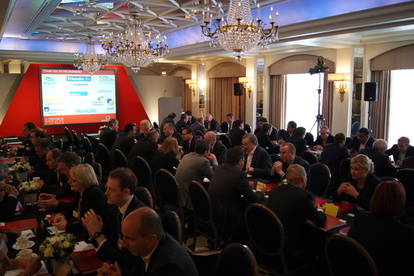

Moderator: Andy Follows - Aquilae
Expert: Steve Parsons - Affinion
“Innovation, what does it mean to you?”
Steve started by sharing this high level question that sits at the top of the funnel he uses to symbolize the start of an innovation journey. The morning’s keynote from David Black of Google had introduced the concepts of 10% and 10x innovation, neatly illustrating the breadth of the topic. Steve explained that he would be sharing a view of innovation through the Affinion lens including some of the typical hurdles that organisations find themselves faced with. The group were invited to share their own drivers for joining the session and topics that they were currently wrestling with. These included:
- how to make innovation everyone’s responsibility
- a desire to hear about other hurdles people were experiencing
- how to encourage people to make innovation part of their business as usual thinking
- how to decide what to dismantle when you are a mature organization that’s struggling to move fast enough
- how to dismantle culture and processes
- how to keep going with energy, without dampening spirits
Steve pointed out that Stefan Lindegaard says we should drop the innovation word. Sometimes innovation is perceived as akin to alchemy, whereas in reality it’s perfectly natural that businesses find themselves in a state of constant flux and this is not a recent phenomenon. The pace of change and extent of potential disruption is what makes our current situation significant. There was no comfort from the reminder that today’s pace of change is as slow as we are ever going to know! The key to success is to not get tied up in semantics but to adopt a process grounded in execution with a focus on addressing a specific challenge, driving through to execute that end point which will deliver value to all parties in a relationship. Affinion is often working in a B2B2C environment where the focus is on adding value to their client and to the client’s end user.
When it comes to sifting priorities, Steve advocates a 70:20:10 approach with 70% of focus going on improvements that will be delivered within 12-18 months, 20% on initiatives that will bring about the next leap in technology and innovation and 10% of resources going into what will come after that. In response to the question on how to make continuous improvement part of business as usual for everyone there was agreement that an organisations attitude and response to failure and mistakes was a key factor. If mistakes are career limiting, people will avoid challenging the status quo. Another enabler to continuous improvement comes from empowering people to make decisions for themselves. Hierarchical decision structures delay execution and can even cause improvements to be blocked completely. Make sure senior managers are enablers rather than gatekeepers advised one participant. When gathering improvement ideas from employees, Steve explained the importance of consistency. People get demoralized if their ideas are not used.
When aiming for those “10x” initiatives, evidence supports setting up separate teams away from the restrictive influence of the existing culture. Dedicated project teams, comprising diverse experts reminiscent of the Apollo 13 approach represent the best way to break free of silo thinking. One member of the group had recently been exposed to thinking around prioritisation that is based entirely on time to execute instead of cost. This approach seems to acknowledge the impact of our ever increasing pace of change in which projects that are going to take what would have historically been a reasonable amount of time to deliver now carries too high a risk of being obsolete before completion.
The start-ups in the room seemed quite used to launching multiple initiatives and pivoting or killing off early those which fail to show early promise. For the mature organisations the advice is to aim for a minimum viable product (MVP) approach and use a small subset of customers and well thought start-up partnerships to accelerate change and gain feedback within meaningful time frames.


